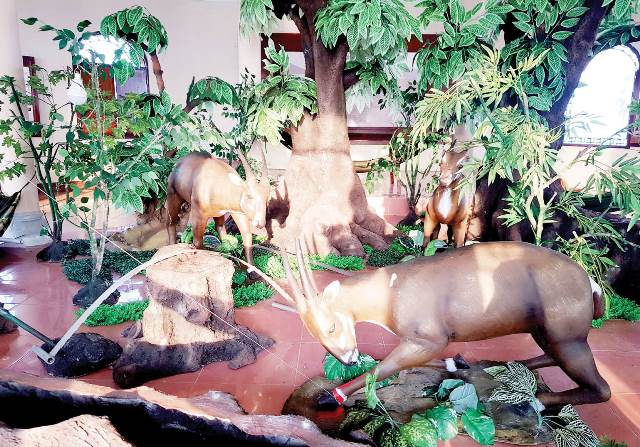Recently, Google has cooperated with WWF-Vietnam - the International Organization for Conservation of Nature in Vietnam to launch the program named "Preserving Saola's Footprints."

Saola’s model is displayed in Vong Hai Dai (Marine Observatory) of Bach Ma National Park
Biodiversity conservation
Until now, there has been no scientists having a chance to see Saola in the wild. The rare "meetings" with Saola are all through camera traps or the occasions that Saola is trapped and then immediately released into the wild or taken care of in a very short period. Therefore, our knowledge relating to Saola's behavior is still limited.
In Thua Thien Hue, this animal, listed as critically endangered in the Red List of threatened species by the International Union for Conservation of Nature (IUCN), was discovered by conservationists in Duong Hoa commune (Huong Thuy Town) for the first time in early 1998.
A representative of Vietnam WWF shared that "Preserving Sao La's Footprints" was divided into two phases, starting from July. The first phase will be bring to the public intriguing information about Saola and resolving common misunderstandings about them.
In the second phase, with a wide range of online interactive activities, the public would be able to understand more about how their daily consumption behavior, directly and indirectly, affects Saola, wildlife, and nature. Thereby, each individual could make daily changes or adjustments to contribute to saving Saola and preserving Vietnam's biodiversity.
"Saola symbolizes all the important things that are now in danger. If we can save Saola, we will be able to save the forest landscape, biodiversity and benefits brought to us by the ecosystem, such as the fresh water that we depend on. Therefore, this is not solely about protecting an endangered species but also a fight to save nature, ecological benefits, community livelihoods, and all that Saola represents," affirmed Dr. Van Ngoc Thinh, Director of WWF Vietnam.
According to conservation experts, Sao la only lives and appears along the majestic Truong Son mountain range, where there is the border between Vietnam and Laos. This affirms the symbol of biodiversity for Vietnam and the whole Asian region. Therefore, together with other conservation areas, Saola Conservation Area in Thua Thien Hue was established, joined with Bach Ma National Park to form a continuous and unified conservation corridor.
Raising public awareness
Mr. Nguyen Thanh, Director of Saola Conservation Area in Thua Thien Hue, shared that the story of two Saola individuals discovered in the province in 1998 marked a significant milestone for the distribution of this species on the biodiversity map of the region.
These findings included a male species (52 kg) seen in Ho village, Duong Hoa commune, Huong Thuy district (now Huong Thuy town), and a pregnant female species (80 kg) in the forest area of the Huong Nguyen commune, A Luoi district.
The third and equally important discovery was in 1999, a baby Saola weighing 10 kg appeared in But village, Huong Nguyen commune.
"These discoveries have made an enormous contribution to the biodiversity treasure not only for Vietnam but also for worldwide scientists. A large mammal species has existed for a long time, yet it was not discovered until the end of the twentieth century and still exists with many mysteries in the natural forest area of Thua Thien Hue province.
Losing Saola is a sign of the loss of primary forests, which are part of the natural heritage on which we rely. This is also an alarm bell for the loss of biodiversity due to human activities and the unsustainable use of natural resources," affirmed Mr. Thanh.
During the "Preserving Sao La Footprints" program, Mr. Thanh stated that they would deploy it to all officers and employees of the unit, acting as a bridge to propagate it to their families and the community. Furthermore, there will be mobile propagandas along with images and banners to make influence and draw attention to the public.
According to Mr. Nguyen Thanh, Director of Saola Conservation Area in Thua Thien Hue, since its inception in 2013, the conservation area has played a crucial role in the research and conservation progress of Saola. This is where domestic and foreign scientists conduct research on wildlife in general and Saola in particular, contributing to protecting the intact ecosystem, living area of Saola, and wildlife.
From these activities, it is hoped that the program would raise public awareness in forest management and protection and biodiversity conservation, minimizing the risk of affecting the development of wild animals, preserving the remaining natural resource values in the Central Truong Son region.
Story and photo: Nhat Minh